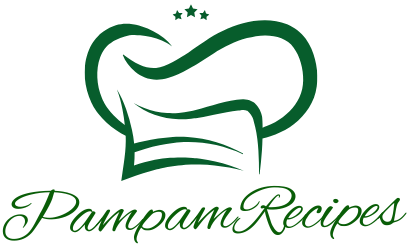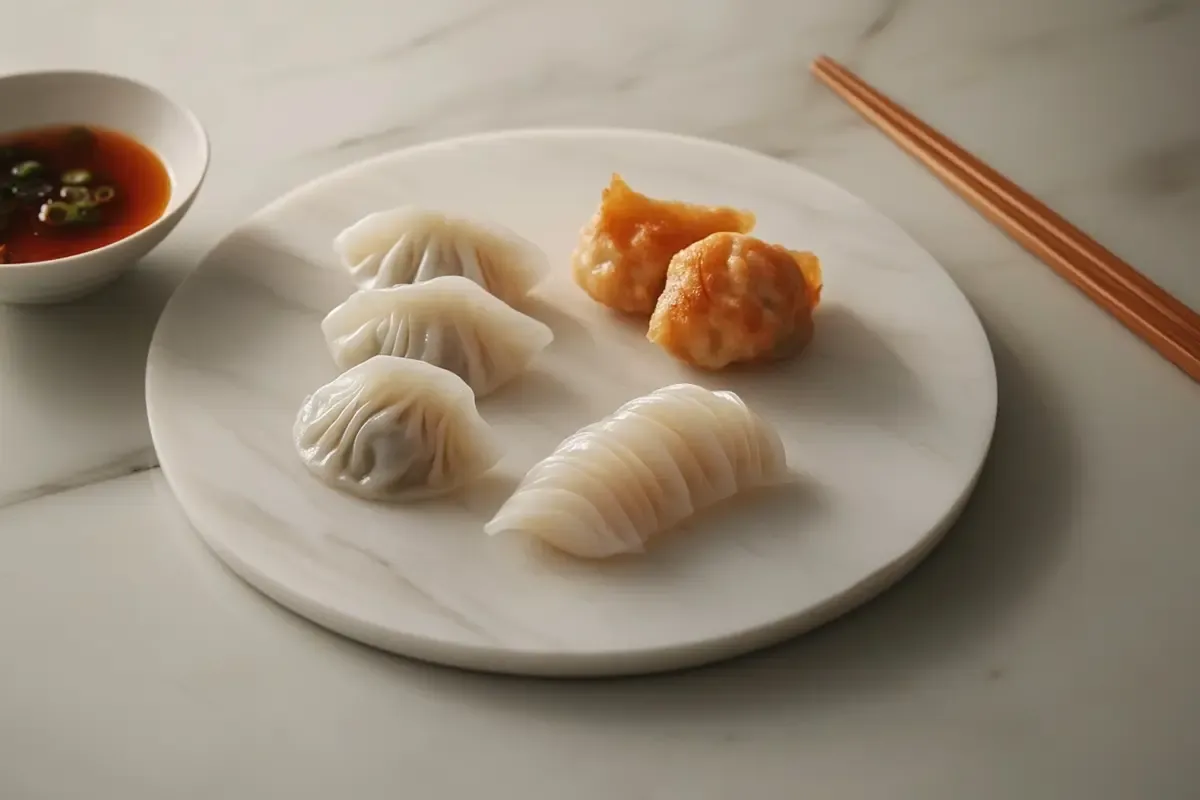Introduction: Discover the Delicious World of Dumplings
Dumplings are more than just food—they’re a universal comfort, found in cuisines across the globe. From the steamy baskets of dim sum to crispy golden samosas, dumplings come in countless forms and flavors. But what are the three types of dumplings? Knowing the main types—boiled, steamed, and fried—can help you better understand and enjoy this versatile dish.
In this article, we’ll explore everything you need to know about dumplings. From their cultural significance to how they’re made, you’ll uncover the secrets of these tasty little parcels. We’ll even share a recipe so you can try making them at home. Ready to dive into the world of dumplings? Let’s begin!
An Introduction to Dumplings
What Are Dumplings?
Dumplings are small pockets of dough stuffed with a variety of fillings, such as vegetables, meat, or even sweet ingredients. They’re typically cooked by boiling, steaming, or frying, and they can be found in almost every culture around the world. Whether you’re savoring a bowl of wonton soup, biting into a pan-fried gyoza, or enjoying a plate of pierogis, dumplings never fail to delight.
But dumplings aren’t just about the taste—they’re a symbol of togetherness. Many traditions involve making dumplings as a family activity, with each person contributing to folding and filling these little treats.
The Cultural Significance of Dumplings
Across the globe, dumplings hold cultural importance. In China, for example, dumplings are a staple during Lunar New Year celebrations, symbolizing prosperity and family unity. Meanwhile, in Eastern Europe, pierogis and pelmeni represent comfort food for generations. India’s momos and samosas are street food favorites, cherished for their portability and bold flavors.
These dishes are more than just recipes—they’re stories passed down through generations. Whether served at a festive gathering or made to celebrate a special occasion, dumplings bring people together in a way few foods can.
The Three Main Types of Dumplings
1. Boiled Dumplings
Boiled dumplings are a classic and versatile type of dumpling found in many cuisines worldwide. They’re cooked in water or broth, which keeps them tender and flavorful. Examples include Chinese wontons, Russian pelmeni, and Polish pierogis.
Why Boiled Dumplings Are Popular
Boiling allows dumplings to absorb moisture, creating a soft and satisfying bite. This method is also quick and doesn’t require additional cooking fats. Boiled dumplings are commonly served in soups, stews, or with simple toppings like melted butter and herbs.
Tips for Perfect Boiled Dumplings
To prevent sticking, stir gently during cooking. Boil until the dumplings float to the surface, signaling they’re done. Pair them with sauces or broths to enhance the taste.
2. Steamed Dumplings
Steamed dumplings are another beloved variety, known for their light texture and delicate flavor. Common examples include Chinese xiao long bao, Tibetan momos, and Cantonese har gow.
The Appeal of Steamed Dumplings
Steaming preserves the natural flavors of the filling while keeping the dough soft and tender. This method is also healthier since it doesn’t require added fats.
How to Steam Dumplings Like a Pro
Line your steamer with parchment paper or cabbage leaves to prevent sticking. Arrange the dumplings with space between them to allow even cooking. Steaming typically takes 8–10 minutes, depending on size.
3. Fried Dumplings
For those who love a crispy bite, fried dumplings are the way to go. This category includes pan-fried gyoza, deep-fried samosas, and crispy wontons.
Why Fried Dumplings Are a Fan Favorite
Frying adds a crunchy exterior that contrasts beautifully with the soft filling. Pan-frying creates golden bottoms while keeping the tops tender, while deep-frying yields an all-around crispy texture.
Tips for Frying Dumplings
Use a nonstick pan for pan-fried dumplings, and heat oil before adding them to prevent sticking. For deep-frying, maintain a consistent oil temperature to ensure even cooking.
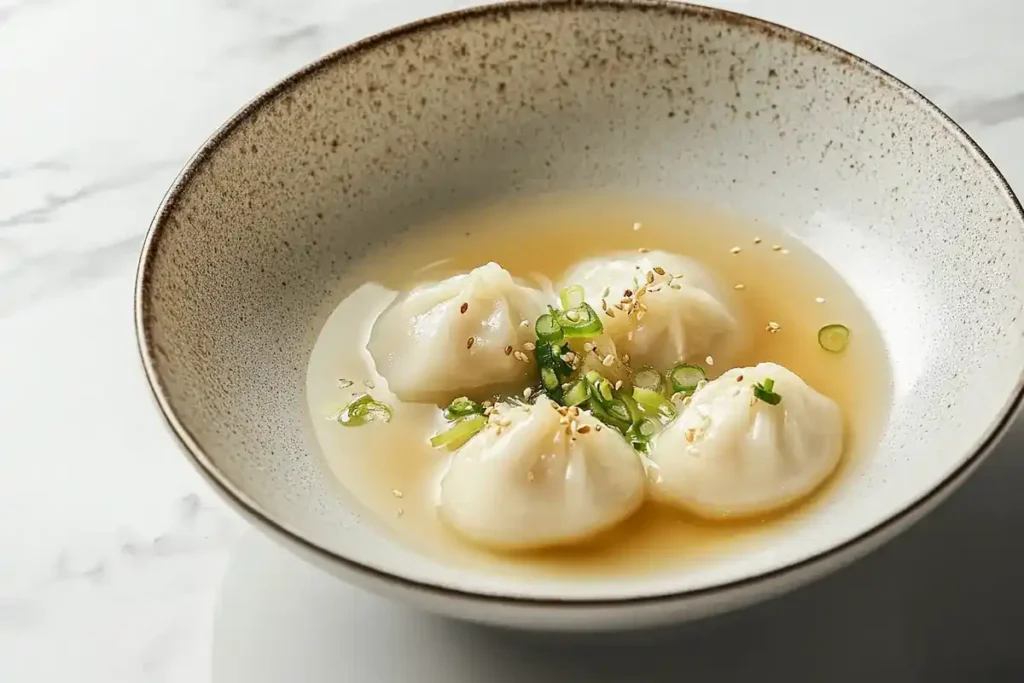
A Versatile Dumpling Recipe to Try at Home
Ingredients for Homemade Dumplings
For the Dough:
- 2 cups all-purpose flour
- ½ cup warm water
- ¼ teaspoon salt
For the Filling (Meat Option):
- 200g ground pork or chicken
- 1 cup finely chopped cabbage
- 1 teaspoon minced ginger
- 2 tablespoons soy sauce
- 1 tablespoon sesame oil
also Filling (Vegetarian Option):
- 1 cup chopped mushrooms
- ½ cup grated carrots
- 1 cup finely chopped spinach
- 1 teaspoon minced garlic
- 1 tablespoon soy sauce
Step-by-Step Cooking Instructions for Dumplings
Making the Dough:
- Mix the flour and salt in a large bowl. Gradually add warm water, mixing until a dough forms.
- Knead the dough on a floured surface for 8–10 minutes until smooth. Cover and let it rest for 30 minutes.
Preparing the Filling:
- Combine all filling ingredients in a bowl. Mix well and set aside.
Shaping the Dumplings:
- Roll the dough into a thin sheet and cut out circles using a glass or cookie cutter.
- Place a teaspoon of filling in the center of each circle.
- Fold the dough over the filling, pinching the edges to seal.
Cooking Methods:
- Boiled: Drop dumplings into boiling water and cook for 6–8 minutes until they float.
- Steamed: Arrange dumplings in a lined steamer and steam for 8–10 minutes.
- Fried: Heat oil in a pan, add dumplings, and fry until the bottoms are golden. Add water, cover, and steam for 5 minutes to finish.
Nutritional Information for Dumplings
Are Dumplings Healthy?
When people ask, What are the three types of dumplings?, they often wonder which option is the healthiest. Dumplings can be a balanced meal, depending on their ingredients and preparation method. For example, steamed dumplings are lower in fat compared to fried ones, while fillings rich in vegetables and lean proteins add nutritional value.
To make dumplings healthier, consider using whole wheat wrappers or reducing the amount of salt and oil. Incorporating nutrient-dense ingredients like spinach, mushrooms, and tofu can also enhance their health benefits. With homemade dumplings, you control every ingredient, making it easier to adapt to your dietary needs.
Nutritional Content Table
Below is a general nutritional breakdown for 100g of boiled dumplings with a vegetable and chicken filling:
| Nutrient | Amount (per 100g) |
|---|---|
| Calories | 200 kcal |
| Protein | 9 g |
| Carbohydrates | 30 g |
| Fat | 4 g |
| Sodium | 300 mg |
| Fiber | 3 g |
Adjusting the filling and cooking method will impact these values, so feel free to experiment for a healthier twist.
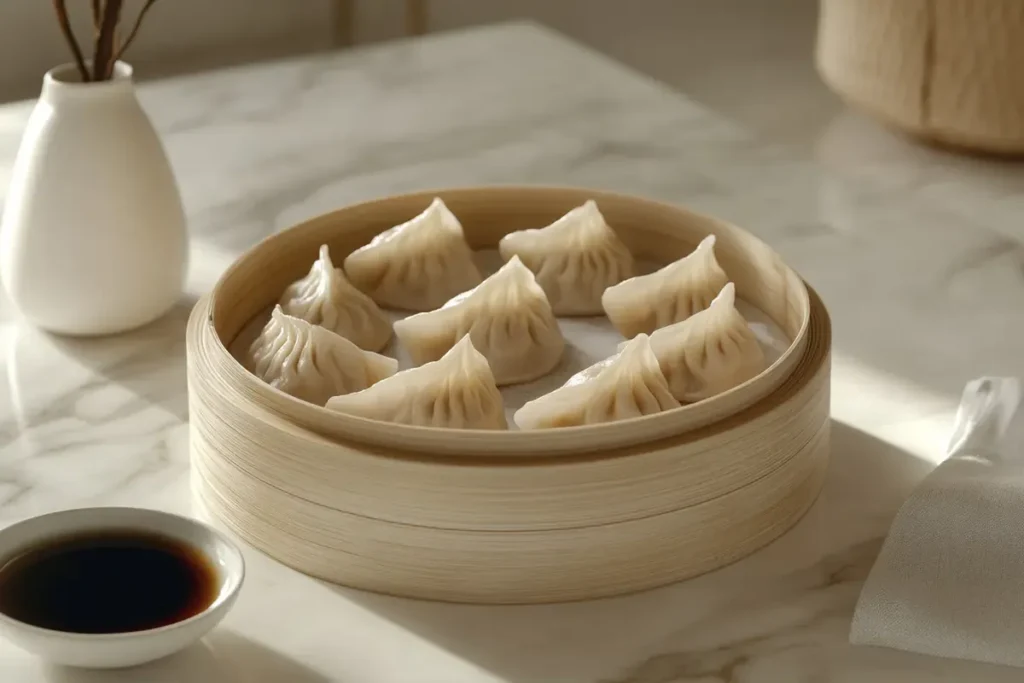
Tips for Perfecting Dumplings
Common Mistakes to Avoid
When exploring What are the three types of dumplings?, it’s equally important to know how to make them right. Here are common mistakes to avoid:
- Overfilling the Dumplings: Adding too much filling can cause the wrapper to tear during cooking. Use a teaspoon or small scoop to keep portions consistent.
- Skipping the Chilling Step: If your filling contains raw meat, chill it before assembling the dumplings to keep the wrapper firm and prevent leaking.
- Not Sealing Edges Properly: A poor seal can lead to fillings spilling out during cooking. Use a small dab of water along the edges for a better bond.
Filling and Wrapping Tips for Beginners
Filling and folding dumplings might seem tricky at first, but practice makes perfect! Here’s how to master it:
- Use Thin Wrappers: Thinner dough ensures even cooking, especially for steamed dumplings.
- Experiment with Shapes: Start with simple half-moon shapes and gradually try pleated or crimped edges for variety.
- Keep the Dough Covered: While shaping, keep unused wrappers covered with a damp cloth to prevent drying out.
With these tips, you’ll be crafting dumplings like a pro in no time!
For More Inspiration
If you’re ready to explore more, check out our Bottom Dumpling Recipe for a unique take on this classic dish. It’s a must-try for dumpling lovers!
Frequently Asked Questions (FAQs)
1. What Are the Three Types of Dumplings?
Dumplings are typically classified into three main types based on their cooking methods: boiled, steamed, and fried. Boiled dumplings, like wontons or pierogis, are tender and often served in soups or with sauces. Steamed dumplings, such as dim sum or momos, have a soft texture and preserve the natural flavors of their fillings. Finally, fried dumplings, like gyoza or samosas, offer a crispy exterior that contrasts beautifully with their soft interiors. Each type has its unique appeal and culinary traditions.
2. What Is the Most Popular Type of Dumpling?
The popularity of dumplings depends on regional preferences. For instance, gyoza and xiao long bao are favorites in East Asia, while pierogis are beloved in Eastern Europe. Fried dumplings tend to be crowd-pleasers because of their crispy texture, but steamed dumplings are preferred for their lightness. Ultimately, your favorite might depend on whether you enjoy a crispy bite, a tender chew, or a comforting soup dumpling.
3. Can Dumplings Be Made Gluten-Free?
Yes, you can make gluten-free dumplings by using a gluten-free flour blend to prepare the wrappers. You can also use rice paper wrappers or lettuce leaves as substitutes. Keep in mind that gluten-free doughs might be more delicate, so handle them gently during shaping. Popular fillings like vegetables, tofu, or shredded chicken work wonderfully with these alternatives.
4. How Should Dumplings Be Stored and Reheated?
To store dumplings, place uncooked ones on a parchment-lined tray and freeze them. Once frozen, transfer them to a freezer-safe bag or container. Cooked dumplings can be refrigerated for up to 2 days. To reheat, steam or pan-fry them to restore their original texture. Avoid microwaving as it can make the wrappers soggy.
Conclusion – Why Dumplings Are Loved Around the World
A Universal Comfort Food
Dumplings are cherished worldwide because they’re comforting, versatile, and delicious. When you explore What are the three types of dumplings?, it becomes clear how these small parcels of flavor bring people together. Whether it’s a bowl of steaming wontons on a chilly evening or crispy samosas at a festive gathering, dumplings have a way of making every moment special.
Encouraging Experimentation
One of the best things about dumplings is their adaptability. You can customize the filling to suit your preferences—add more vegetables for a healthy twist, use seafood for a luxurious touch, or even try sweet fillings for dessert dumplings. With practice, you’ll find that creating dumplings is as fun as eating them.
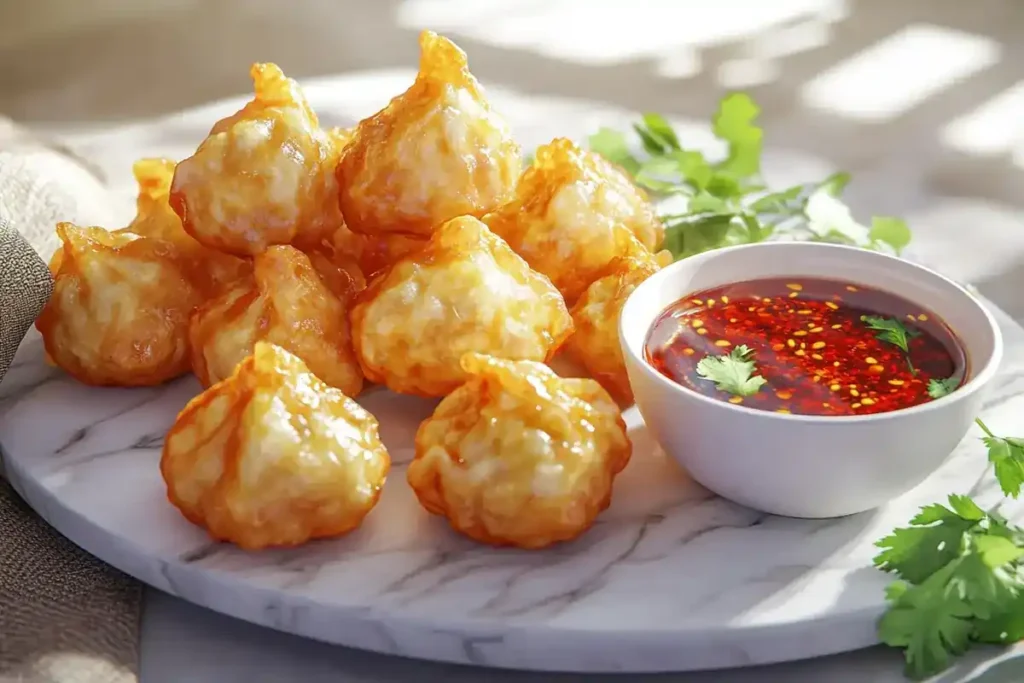
Explore More Recipes
If you’ve enjoyed learning about dumplings, why not try another delicious dish? Check out our Veggie Spring Roll Recipe for a quick and healthy snack that pairs perfectly with any meal!
Common Mistakes to Avoid When Making Dumplings
1. Overstuffing the Dumplings
One of the most common errors when making dumplings is overstuffing them. While it may be tempting to pack in as much filling as possible, doing so can cause the wrappers to tear or the dumplings to burst during cooking. For a smooth process, stick to a teaspoon or small scoop of filling for each wrapper. This ensures that your dumplings are easier to seal and maintain their shape.
2. Not Sealing the Dumplings Properly
A poorly sealed dumpling can unravel during cooking, causing the filling to spill out. To avoid this, lightly dampen the edges of the wrapper with water before sealing. Press firmly along the edges, and consider pleating for a more secure closure. Taking your time to seal each dumpling will save you from disappointment later.
3. Skipping the Resting Time for Dough
If you’re making dumpling wrappers from scratch, resting the dough is essential. Allowing the dough to rest for at least 30 minutes helps it relax, making it easier to roll out thinly. If you skip this step, you may end up with dough that’s too stiff or tears easily.
4. Using the Wrong Cooking Method
Choosing the correct cooking method for your dumplings is key. When exploring What are the three types of dumplings?, it’s clear that some types, like wontons, are best boiled, while others, like gyoza, shine when pan-fried. Using the wrong method can alter the texture and flavor, so always match the cooking style to the dumpling type.
Why Dumplings Are Worth Making at Home
1. A Taste of Tradition
Dumplings are more than just food—they’re a connection to cultural traditions. When you ask, What are the three types of dumplings?, you’re diving into a rich history of culinary art. Making them at home allows you to experience this tradition firsthand. Whether folding wontons with your family or experimenting with fillings, it’s an opportunity to create memories that go beyond the dish itself.
2. Versatile and Customizable
Homemade dumplings are endlessly versatile. You can mix and match fillings, try new folding techniques, or even experiment with different cooking styles. If you love a crispy bite, opt for pan-fried dumplings. Prefer something lighter? Steamed dumplings are a great choice. By making them at home, you can adapt the recipe to suit your taste perfectly.
3. Fun for All Ages
Making dumplings is a fun activity for everyone. Kids enjoy helping to shape and fill the dumplings, while adults can focus on perfecting the folds. It’s a great way to bond with family and friends over a shared culinary project.
Explore More Recipes
Ready to try another fun and delicious dish? Don’t miss our Ultimate Fried Rice Recipe for a flavorful companion to your homemade dumplings!
